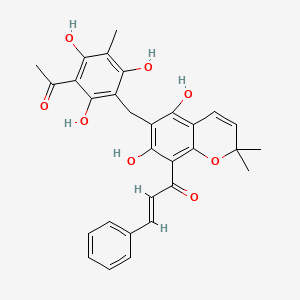| MeSH term | MeSH ID | Detail |
|---|---|---|
| Neoplasms, Experimental | D009374 | 10 associated lipids |
| Adenocarcinoma | D000230 | 166 associated lipids |
| Autoimmune Diseases | D001327 | 27 associated lipids |
| Lung Neoplasms | D008175 | 171 associated lipids |
| Pancreatic Neoplasms | D010190 | 77 associated lipids |
| Colonic Neoplasms | D003110 | 161 associated lipids |
| Diabetes Mellitus, Type 2 | D003924 | 87 associated lipids |
| Diabetic Nephropathies | D003928 | 39 associated lipids |
| Diabetes Mellitus, Experimental | D003921 | 85 associated lipids |
| Body Weight | D001835 | 333 associated lipids |
rottlerin
Rottlerin is a lipid of Polyketides (PK) class. Rottlerin is associated with abnormalities such as PARAGANGLIOMAS 2, Hyperostosis, Diffuse Idiopathic Skeletal, Virus Diseases, Perisylvian syndrome and Autoimmune disease (systemic) NOS. The involved functions are known as Apoptosis, Regulation, Signal Transduction, inhibitors and Proteasome Inhibitors [MoA]. Rottlerin often locates in Clone, Membrane, Body tissue, Plasma membrane and soluble. The associated genes with Rottlerin are XIAP gene, GAPDH gene, ICAM1 gene, P4HTM gene and TNFSF10 gene. The related lipids are Promega, Fatty Acids, Sphingolipids, Lipopolysaccharides and Saponin. The related experimental models are Mouse Model, Xenograft Model and Cancer Model.
Cross Reference
Introduction
To understand associated biological information of rottlerin, we collected biological information of abnormalities, associated pathways, cellular/molecular locations, biological functions, related genes/proteins, lipids and common seen animal/experimental models with organized paragraphs from literatures.
What diseases are associated with rottlerin?
rottlerin is suspected in Infection, Morphologically altered structure, Ischemia, Pulmonary Edema, Asthma, Cardiovascular Diseases and other diseases in descending order of the highest number of associated sentences.
Related references are mostly published in these journals:
- J. Biol. Chem. (5)
- Am. J. Physiol. Heart Circ. Physiol. (3)
- Am. J. Physiol. Lung Cell Mol. Physiol. (3)
- Others (19)
| Disease | Cross reference | Weighted score | Related literature |
|---|
Possible diseases from mapped MeSH terms on references
We collected disease MeSH terms mapped to the references associated with rottlerin
PubChem Associated disorders and diseases
What pathways are associated with rottlerin
There are no associated biomedical information in the current reference collection.
PubChem Biomolecular Interactions and Pathways
Link to PubChem Biomolecular Interactions and PathwaysWhat cellular locations are associated with rottlerin?
Visualization in cellular structure
Associated locations are in red color. Not associated locations are in black.
Related references are published most in these journals:
| Location | Cross reference | Weighted score | Related literatures |
|---|
What functions are associated with rottlerin?
Related references are published most in these journals:
| Function | Cross reference | Weighted score | Related literatures |
|---|
What lipids are associated with rottlerin?
Related references are published most in these journals:
| Lipid concept | Cross reference | Weighted score | Related literatures |
|---|
What genes are associated with rottlerin?
Related references are published most in these journals:
| Gene | Cross reference | Weighted score | Related literatures |
|---|
What common seen animal models are associated with rottlerin?
Cancer Model
Cancer Model are used in the study 'Rottlerin stimulates apoptosis in pancreatic cancer cells through interactions with proteins of the Bcl-2 family.' (Ohno I et al., 2010) and Cancer Model are used in the study 'Rottlerin induces Wnt co-receptor LRP6 degradation and suppresses both Wnt/β-catenin and mTORC1 signaling in prostate and breast cancer cells.' (Lu W et al., 2014).
Mouse Model
Mouse Model are used in the study 'Neuroprotective effect of protein kinase C delta inhibitor rottlerin in cell culture and animal models of Parkinson's disease.' (Zhang D et al., 2007).
Xenograft Model
Xenograft Model are used in the study 'Rottlerin stimulates apoptosis in pancreatic cancer cells through interactions with proteins of the Bcl-2 family.' (Ohno I et al., 2010).
Related references are published most in these journals:
| Model | Cross reference | Weighted score | Related literatures |
|---|
NCBI Entrez Crosslinks
All references with rottlerin
Download all related citations| Authors | Title | Published | Journal | PubMed Link |
|---|---|---|---|---|
| Kitazawa M et al. | Dieldrin induces apoptosis by promoting caspase-3-dependent proteolytic cleavage of protein kinase Cdelta in dopaminergic cells: relevance to oxidative stress and dopaminergic degeneration. | 2003 | Neuroscience | pmid:12831855 |
| Matthews V et al. | Cellular cholesterol depletion triggers shedding of the human interleukin-6 receptor by ADAM10 and ADAM17 (TACE). | 2003 | J. Biol. Chem. | pmid:12832423 |
| Shukla A et al. | Asbestos-induced apoptosis is protein kinase C delta-dependent. | 2003 | Am. J. Respir. Cell Mol. Biol. | pmid:12626342 |
| Gore-Hyer E et al. | Selective stimulation of collagen synthesis in the presence of costimulatory insulin signaling by connective tissue growth factor in scleroderma fibroblasts. | 2003 | Arthritis Rheum. | pmid:12632435 |
| Saraiva L et al. | Isoform-selectivity of PKC inhibitors acting at the regulatory and catalytic domain of mammalian PKC-alpha, -betaI, -delta, -eta and -zeta. | 2003 | J Enzyme Inhib Med Chem | pmid:15008511 |
| Ni H et al. | Protein kinase C-delta is commonly expressed in multiple myeloma cells and its downregulation by rottlerin causes apoptosis. | 2003 | Br. J. Haematol. | pmid:12786795 |
| Wang Q et al. | Induction of cIAP-2 in human colon cancer cells through PKC delta/NF-kappa B. | 2003 | J. Biol. Chem. | pmid:14527959 |
| Wrede CE et al. | Fatty acid and phorbol ester-mediated interference of mitogenic signaling via novel protein kinase C isoforms in pancreatic beta-cells (INS-1). | 2003 | J. Mol. Endocrinol. | pmid:12790799 |
| Deb DK et al. | Activation of protein kinase C delta by IFN-gamma. | 2003 | J. Immunol. | pmid:12817007 |
| Susarla BT and Robinson MB | Rottlerin, an inhibitor of protein kinase Cdelta (PKCdelta), inhibits astrocytic glutamate transport activity and reduces GLAST immunoreactivity by a mechanism that appears to be PKCdelta-independent. | 2003 | J. Neurochem. | pmid:12859677 |
